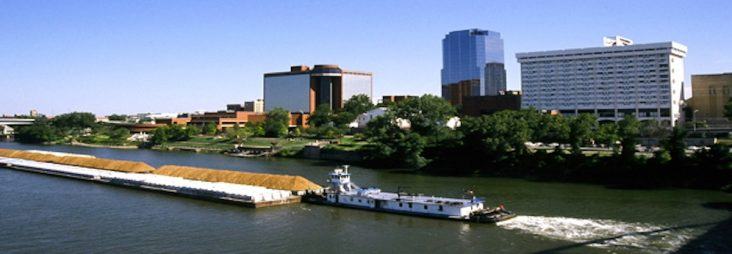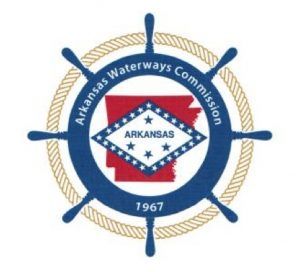Arkansas Waterway Commission hosts meeting-of-minds to push river issues forward
by July 28, 2016 7:03 pm 446 views

Gene Higginbotham of the Arkansas Waterway Commission (AWC) knows that organizing an alphabet of economic development and freight transport organizations can be difficult. After all, “these people are rarely in the same place at the same time,” he said in recent comments to Talk Business & Politics.
But on Thursday (July 28), he and Dede Smith of the Oklahoma Department of Transportation (ODOT) hosted what they hope will be a “first step” in the process of building an orchestrated effort to maximize opportunities along the McClellan-Kerr Arkansas River Navigation System (MKARNS).
The first ever Arkansas River Marine Highway 40 (M40) Strong Ports Workshop – held at the Fort Smith Convention Center – welcomed representatives from the Maritime Administration (MARAD), as well as the Arkansas Department of Transportation (ADOT), U.S. Army Corps of Engineers (USACE), the Indian Nations Council of Governments (INCOG), and Metropolitan Planning Organizations (MPOs) from Little Rock and Fort Smith. Also participating were presenters from the University of Arkansas; Inland Rivers, Ports and Terminals, Inc. (IRPT); and the Ports of Little Rock, Muskogee, Catoosa, and Fort Smith.
“The purpose of doing this is to let MPOs hear about alternative forms of financing, and things the federal government might have that the ports can use as well as sources from the Oklahoma DOT and Maritime Administration. Anything that will help keep freight moving,” Higginbotham said.
The McClellan-Kerr Arkansas River Navigation System contributes total impacts of $8.5 billion in sales, $289 million in taxes with a majority of that in Arkansas ($168 million), and 55,872 jobs to the national economy (33,695 in Arkansas), according to a study from the University of Arkansas. The MKARNS was classified as a high-use waterway system in February 2015 based on a 5-year average of 3.3 billion tons transported.
DIFFERENT GROUPS, SAME CHALLENGES
The symposium offered presenters the opportunity to learn from each other’s challenges and successes with the main goal “to let people know we’ve got the same challenges ahead, and it’s time to get efforts underway. We want this dialogue to continue.”

“We’ve gotten it started. Now we need to continue it,” Higginbotham said. “I don’t know if that will mean a couple of more meetings here in Fort Smith or not. It is always a good place to meet when you’re talking about a midway point between Tulsa and Little Rock.”
Higginbotham hopes the meeting-of-minds can “incrementally do things to help our ports become stronger and to try to grow what we use of the Arkansas River.” He said usage of the Arkansas River is at 30%, “so we can afford to move some of our freight traffic to the water.”
According to the International Transport Forum (ITF), population growth is expected to hit 9.1 billion by 2050 with urban centers growing from 50% of that makeup to 70% globally, increasing truck traffic as well as overall congestion and emissions.
“Freight is going to continue to grow through 2050 astronomically, and we need to start addressing it now by creating efficiencies,” Higginbotham said.
Part of doing that, according to Van Buren-based Five Rivers Distribution’s Marty Shell (representing the Port of Fort Smith and port facilities in Van Buren), is for each port to do a better job of educating the public on the importance of their area’s waterways.
“We’ve grown tremendously in the time this river system has been in place, but we’ve failed tremendously by not putting infrastructure back into what we have. We now have 70% (of the River) we can grow on, but we’ve failed in educating communities of the assets they have.”
The Port of Fort Smith employs 20, but as Higginbotham adds, it supports 7,000 industrial jobs “for industries in western Arkansas, from Rogers down to Mena.”
“Water is the most efficient form of transportation and that’s what industry looks for. It’s just another cog in making Arkansas stronger when it comes to industry, and that’s what we’ve got here,” Higginbotham said.
CONTAINER-ON-BARGE SHIPPING
A new efficiency that struck a chord with Thursday’s audience was container-on-barge shipping, detailed by IRPT’s Aimee Anders in the closing address. Container-on-barge is a form of intermodal freight transport where containers are stacked on a barge and towed to a destination on the inland waterway.
Anders said the method’s efficiency depends on coordination between origin and destination (O&D) points where the launch cities work with the delivery cities to consolidate freight, thus reducing the amount of overall intermodal traffic. IRPT was recently awarded product designation for Marine Highways M55 and M35 (the Mississippi and Illinois Rivers, respectively). Anders said container-on-barge benefits the public by reducing transportation costs, road maintenance costs, and air emissions while improving safety by cutting back on truck traffic.
As part of the Marine Highway Project approved in 2014, container-on-barge could positively affect cities along M55 and M35 waterways as well as cities along the Arkansas, Missouri, Ohio, and Red Rivers.
